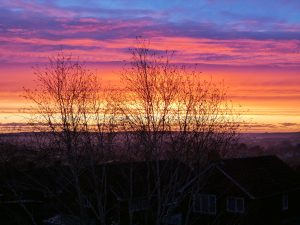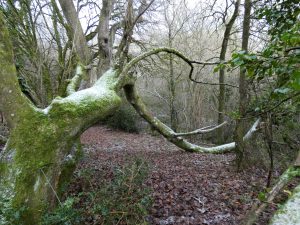I woke up in the middle of last night with what could only be called an anxiety. The fear was one of possibly being overwhelmed. Since I decided to join Extinction Rebellion last spring, I have stayed at the edge of it – watching, listening, and learning. I have observed how many of the other local members are really involving themselves in terms of their time and commitment, but not felt I wanted this level of involvement. I joined the XR Devon Drummers and attend practices most Sunday afternoons, as well as playing with them in a few local actions. The furthest I have gone with them is to Plymouth. I still feel at the edge of the band, and am quite happy with this. It’s challenging enough for me to play a new instrument (agogo) and also understand all the signals, and I am still on a learning curve. I want to be more-or-less confident by the time April comes when I intend to go up to London and play.
But yesterday I went to a meeting with a different XR group – the biodiversity group – and found myself stepping over the edge a bit. The group want to plan something “eye-catching” for Earth Day during the April rebellion outside Parliament that confronts current fishing and farming practices and legislation. I volunteered to take notes – simple enough and an “at the edge” kind of role – but somehow I began feeling more “involved” and was informed of the need to learn a lot more about how XR communicate and operate. Why should this matter? After all, I really want to do something meaningful to help protect the wildlife and natural environment.
Central to my enquiry into The Edge is “feeling the edge” – being sensitive and aware about how I respond to opening to and moving in any direction at a perceived edge. The edge is a place of risk. Of course, whatever direction one moves in will bring change – but an edge has a sense of some real unknown, some risk. So, I woke up with anxiety. I identified the perceived edge here as between Being and Doing. All my adult life, until I retired, I was mostly a “Doer”, despite the longing to “Be”. Since then I have been learning to “Be” – giving it space in my life and becoming sensitive to the joys it brings. It is essential to my poetry, to my whole inner life, and also to my ability to relate. I still like to do, but work hard to find the balance between them. For me, it is an edge. Having both the mini-stroke and then Long Covid taught me a lot about just being, as I couldn’t do otherwise. There were immense gifts from these experiences. I am at the edge now, feeling the risk of loss and overwhelm if I go too far into doing. I want to do more for XR, but fear losing some of the other parts of my life that nourish me: writing, editing, immersing myself in nature, dharma practice, this enquiry…
I was finally able to go back to sleep after making some notes, identifying the fear and jotting down some strategies for handling this particular edge. When writing about my desire for freedom in Touching the Flame, I recognised a desire to be held or contained as well. I think this is what is needed at this edge. I need containers around time and commitment. At the moment these involve my making a list of what I want in my life in terms of doing and being, and using my diary to put in spaces for each. We shall see if this is enough to enable me to move and balance at this edge.

